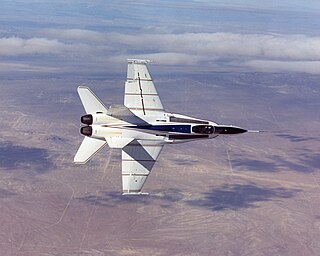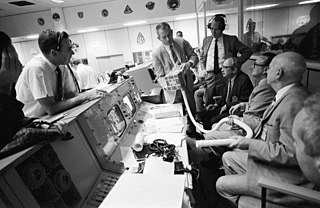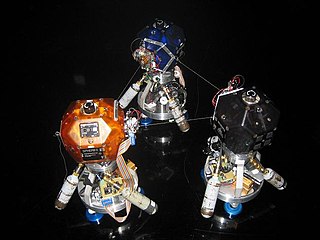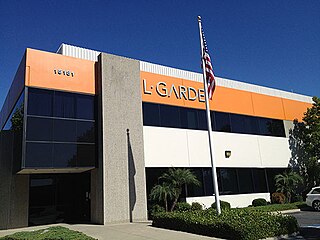
An aerobot is an aerial robot, usually used in the context of an unmanned space probe or unmanned aerial vehicle.

Aeroelasticity is the branch of physics and engineering studying the interactions between the inertial, elastic, and aerodynamic forces occurring while an elastic body is exposed to a fluid flow. The study of aeroelasticity may be broadly classified into two fields: static aeroelasticity dealing with the static or steady state response of an elastic body to a fluid flow; and dynamic aeroelasticity dealing with the body's dynamic response.

The Grumman X-29 was an American experimental aircraft that tested a forward-swept wing, canard control surfaces, and other novel aircraft technologies. The X-29 was developed by Grumman, and the two built were flown by NASA and the United States Air Force. The aerodynamic instability of the X-29's airframe required the use of computerized fly-by-wire control. Composite materials were used to control the aeroelastic divergent twisting experienced by forward-swept wings, and to reduce weight. The aircraft first flew in 1984, and two X-29s were flight tested through 1991.

Robert T. (Bob) Jones,, was an aerodynamicist and aeronautical engineer for NACA and later NASA. He was known at NASA as "one of the premier aeronautical engineers of the twentieth century".

Dr. Pedro Rodriguez, Ph.D.,, is the Director of a test laboratory at NASA and inventor of a portable, battery-operated lift seat for people suffering from knee arthritis.

A blended wing body (BWB), Blended body or Hybrid Wing Body (HWB) is a fixed-wing aircraft having no clear dividing line between the wings and the main body of the craft. The aircraft has distinct wing and body structures, which are smoothly blended together with no clear dividing line. This contrasts with a flying wing, which has no distinct fuselage, and a lifting body, which has no distinct wings. A BWB design may or may not be tailless.

The X-53 Active Aeroelastic Wing (AAW) development program is a completed American research project that was undertaken jointly by the Air Force Research Laboratory (AFRL), Boeing Phantom Works and NASA's Dryden Flight Research Center, where the technology was flight tested on a modified McDonnell Douglas F/A-18 Hornet. Active Aeroelastic Wing Technology is a technology that integrates wing aerodynamics, controls, and structure to harness and control wing aeroelastic twist at high speeds and dynamic pressures. By using multiple leading and trailing edge controls like "aerodynamic tabs", subtle amounts of aeroelastic twist can be controlled to provide large amounts of wing control power, while minimizing maneuver air loads at high wing strain conditions or aerodynamic drag at low wing strain conditions. This program was the first full-scale proof of AAW technology.

The Common Berthing Mechanism (CBM) connects habitable elements in the US Orbital Segment (USOS) of the International Space Station (ISS). The CBM has two distinct sides that, once mated, form a cylindrical vestibule between modules. The vestibule is about 16 inches (0.4 m) long and 6 feet (1.8 m) across. At least one end of the vestibule is often limited in diameter by a smaller bulkhead penetration.

Ares I-X was the first-stage prototype and design concept demonstrator in the Ares I program, a launch system for human spaceflight developed by the United States space agency, NASA. Ares I-X was successfully launched on October 28, 2009. The project cost was $445 million.

The Finite Element Machine (FEM) was a late 1970s-early 1980s NASA project to build and evaluate the performance of a parallel computer for structural analysis. The FEM was completed and successfully tested at the NASA Langley Research Center in Hampton, Virginia. The motivation for FEM arose from the merger of two concepts: the finite element method of structural analysis and the introduction of relatively low-cost microprocessors.
Expansion and shock tunnels are aerodynamic testing facilities with a specific interest in high speeds and high temperature testing. Shock tunnels use steady flow nozzle expansion whereas expansion tunnels use unsteady expansion with higher enthalpy, or thermal energy. In both cases the gases are compressed and heated until the gases are released, expanding rapidly down the expansion chamber. The tunnels reach speeds from Mach 3 to Mach 30 to create testing conditions that simulate hypersonic to re-entry flight. These tunnels are used by military and government agencies to test hypersonic vehicles that undergo a variety of natural phenomenon that occur during hypersonic flight.

Aerospace engineering is the primary field of engineering concerned with the development of aircraft and spacecraft. It has two major and overlapping branches: aeronautical engineering and astronautical engineering. Avionics engineering is similar, but deals with the electronics side of aerospace engineering.

Jeanette Jo Epps is an American aerospace engineer and NASA astronaut. Epps received both her M. S. and Ph.D degrees in aerospace engineering from the University of Maryland, where she was part of the rotor-craft research group and was a NASA GSRP Fellow. She was chosen for 20th class of NASA astronauts in 2009, graduating in 2011. Epps currently serves as a member of the ISS Operations Branch and has completed analog astronaut missions, including NEEMO 18 and CAVES 19. She is the second woman and first African-American woman to have participated in CAVES.

Tethered formation flying is one of applications for space tethers. This sub-set represents an entire area of research using a non-conductive tether to connect multiple spacecraft.

A number of space tethers have been deployed in space missions. Tether satellites can be used for various purposes including research into tether propulsion, tidal stabilisation and orbital plasma dynamics.

LGarde, also L'Garde or L·Garde, is an American aerospace and defense technology company founded in 1971 in Orange County, CA and is the primary contractor for the Sunjammer spacecraft, the world largest solar sail. The company was an early pioneer of thin-skinned, multi-task inflatable structures used in various military and space applications. At the height of the Cold War, L·Garde developed and manufactured inflatable targets and decoy systems for U.S. military defense, and countermeasure systems for the Strategic Defense Initiative. After the Cold-War, the company used the technologies and manufacturing techniques it had developed to land a contract to design and build the inflatable antenna experiment and other thin-film inflatable space structures using its unique application of rigidizable tube technology. The company's unusual name is an acronym formed by the initials of the founding partners: Bill Larkin, Gayle Bilyeu, Alan Hirasuna, Rich Walstrom, Don Davis. The "E" comes from the Latin term "et al" as a tip to other partners and original employees of the company.

Standard wind tunnel models, also known as reference models, calibration models or test check-standards are objects of relatively simple and precisely defined shapes, having known aerodynamic characteristics, that are tested in wind tunnels. Standard models are used in order to verify, by comparison of wind tunnel test results with previously published results, the complete measurement chain in a wind tunnel, including wind tunnel structure, quality of the airstream, model positioning, transducers and force balances, data acquisition system and data reduction software.
Guru Guruswamy is an American engineer working as Principal Scientist at Ames Research Center since 1988. He pioneered research in the area of computational aeroelasticity that involves Unsteady Aerodynamics, Finite Element Methods, Computational Fluid Dynamics, Parallel Computing and Problem Solving Environment. His innovative research was utilized in the first commercial 3-D computational aeroelasticity software developed by a major aerospace industry. The aeroelasticity legend Holt Ashley extensively referred to Guruswamy's research in his classical review paper. In 1988 he demonstrated the unique use of Transonic Small Perturbation based CFD for designing active controls to increase the safety of aircraft. It was followed by a break through development of Euler flow equations based Computational Aeroelasticy. It was cited by another Aeroelasticity legend John Dugundji of MIT as an important milestone in Aeroelasticity. A google search shows about 150 researchers took advantage Guruswamy's work based on the Euler equations for follow-up developments.

Dr. James E. Hubbard, Jr. is a mechanical engineer who has made significant contributions to the field of aerospace engineering throughout a career spanning more than four decades in academia and industry.

















